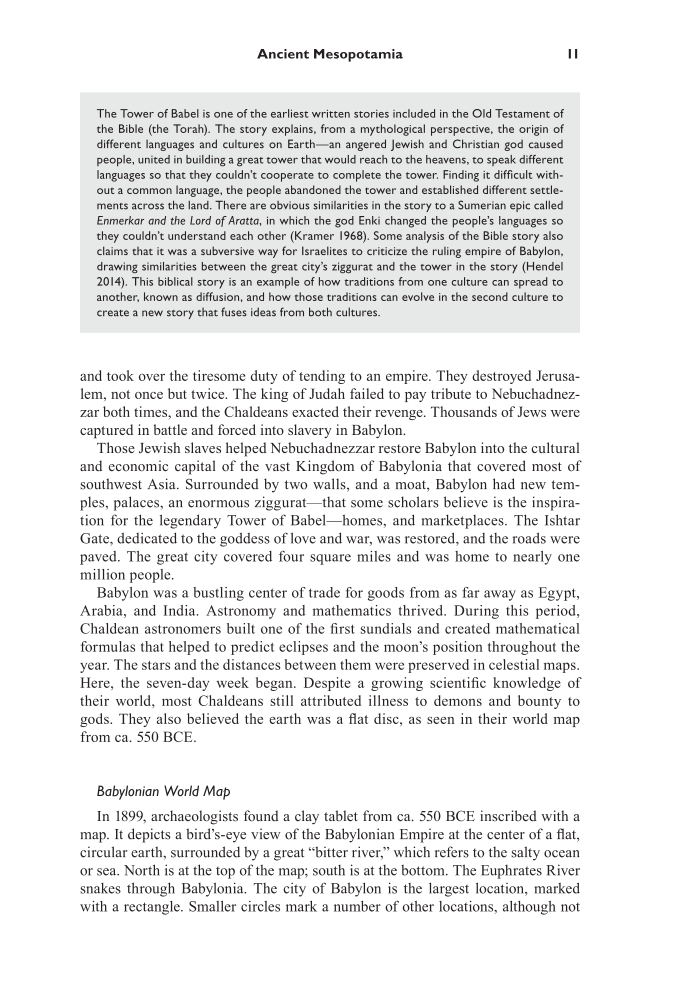Ancient Mesopotamia 11 and took over the tiresome duty of tending to an empire. They destroyed Jerusa- lem, not once but twice. The king of Judah failed to pay tribute to Nebuchadnez- zar both times, and the Chaldeans exacted their revenge. Thousands of Jews were captured in battle and forced into slavery in Babylon. Those Jewish slaves helped Nebuchadnezzar restore Babylon into the cultural and economic capital of the vast Kingdom of Babylonia that covered most of southwest Asia. Surrounded by two walls, and a moat, Babylon had new tem- ples, palaces, an enormous ziggurat—that some scholars believe is the inspira- tion for the legendary Tower of Babel—homes, and marketplaces. The Ishtar Gate, dedicated to the goddess of love and war, was restored, and the roads were paved. The great city covered four square miles and was home to nearly one million people. Babylon was a bustling center of trade for goods from as far away as Egypt, Arabia, and India. Astronomy and mathematics thrived. During this period, Chaldean astronomers built one of the first sundials and created mathematical formulas that helped to predict eclipses and the moon’s position throughout the year. The stars and the distances between them were preserved in celestial maps. Here, the seven-day week began. Despite a growing scientific knowledge of their world, most Chaldeans still attributed illness to demons and bounty to gods. They also believed the earth was a flat disc, as seen in their world map from ca. 550 BCE. Babylonian World Map In 1899, archaeologists found a clay tablet from ca. 550 BCE inscribed with a map. It depicts a bird’s-eye view of the Babylonian Empire at the center of a flat, circular earth, surrounded by a great “bitter river,” which refers to the salty ocean or sea. North is at the top of the map south is at the bottom. The Euphrates River snakes through Babylonia. The city of Babylon is the largest location, marked with a rectangle. Smaller circles mark a number of other locations, although not The Tower of Babel is one of the earliest written stories included in the Old Testament of the Bible (the Torah). The story explains, from a mythological perspective, the origin of different languages and cultures on Earth—an angered Jewish and Christian god caused people, united in building a great tower that would reach to the heavens, to speak different languages so that they couldn’t cooperate to complete the tower. Finding it difficult with- out a common language, the people abandoned the tower and established different settle- ments across the land. There are obvious similarities in the story to a Sumerian epic called Enmerkar and the Lord of Aratta, in which the god Enki changed the people’s languages so they couldn’t understand each other (Kramer 1968). Some analysis of the Bible story also claims that it was a subversive way for Israelites to criticize the ruling empire of Babylon, drawing similarities between the great city’s ziggurat and the tower in the story (Hendel 2014). This biblical story is an example of how traditions from one culture can spread to another, known as diffusion, and how those traditions can evolve in the second culture to create a new story that fuses ideas from both cultures.
Document Details My Account Print multiple pages
Print
You have printed 0 times in the last 24 hours.
Your print count will reset on at .
You may print 0 more time(s) before then.
You may print a maximum of 0 pages at a time.























































































































































































































































































































































































